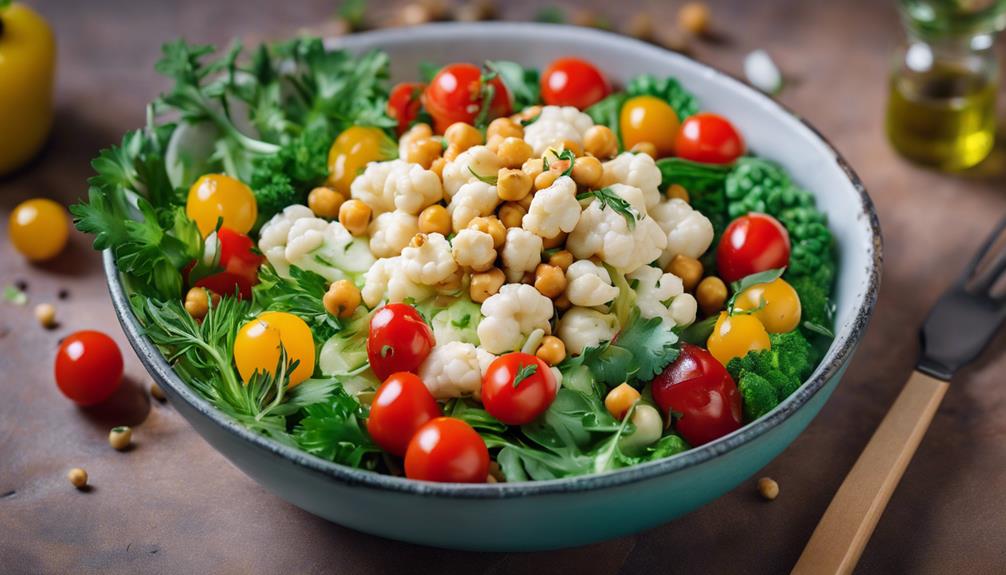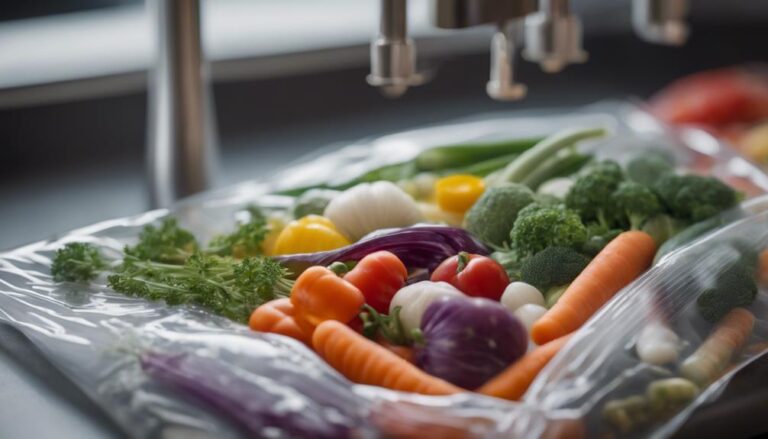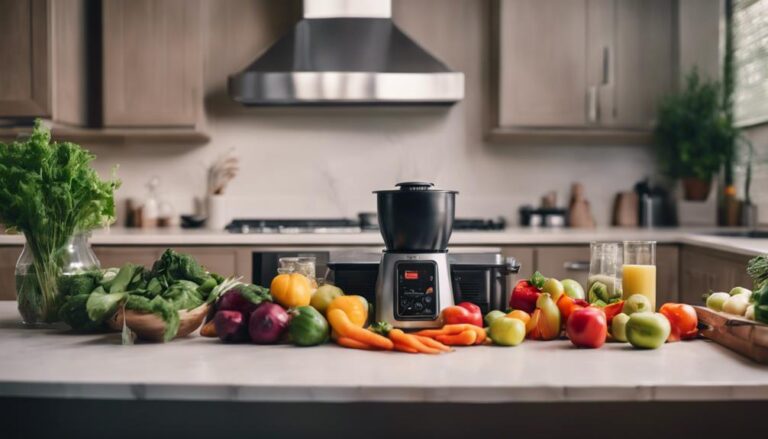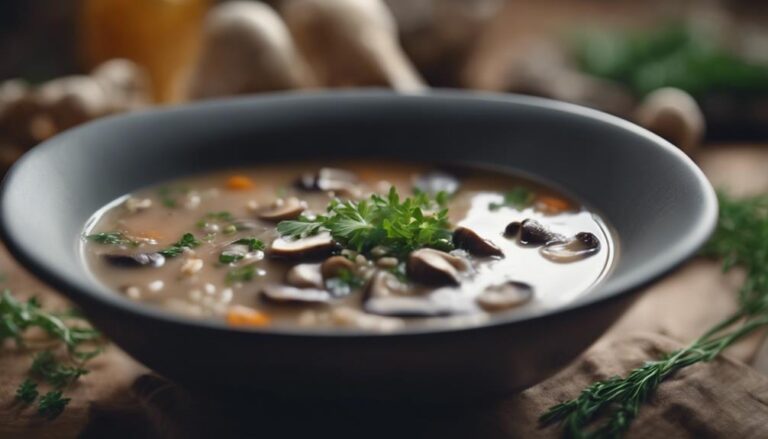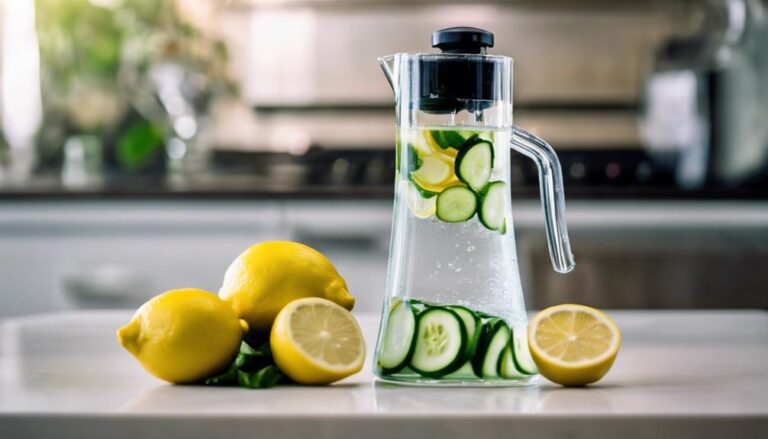Salad Sous Vide Cauliflower and Chickpea Salad
Immerse in a symphony of flavors with a Sous Vide Cauliflower and Chickpea Salad. Experience tender sous vide cauliflower harmonizing flawlessly with crispy chickpeas, crafting a culinary masterpiece. This salad blend promises a delightful fusion of textures and tastes, elevating your meal to a new level of gastronomic delight.
What You Will Learn Here
- Sous vide cooking enhances cauliflower and chickpeas' natural flavors and textures.
- Precision temperature control ensures even cooking for a perfectly tender salad.
- Fresh herbs and citrus zest elevate the salad's taste and aroma.
- Creamy dressing binds the ingredients together for a velvety finish.
- Crunchy chickpeas provide a satisfying texture and protein boost to the salad.
Origins of Sous Vide Technology
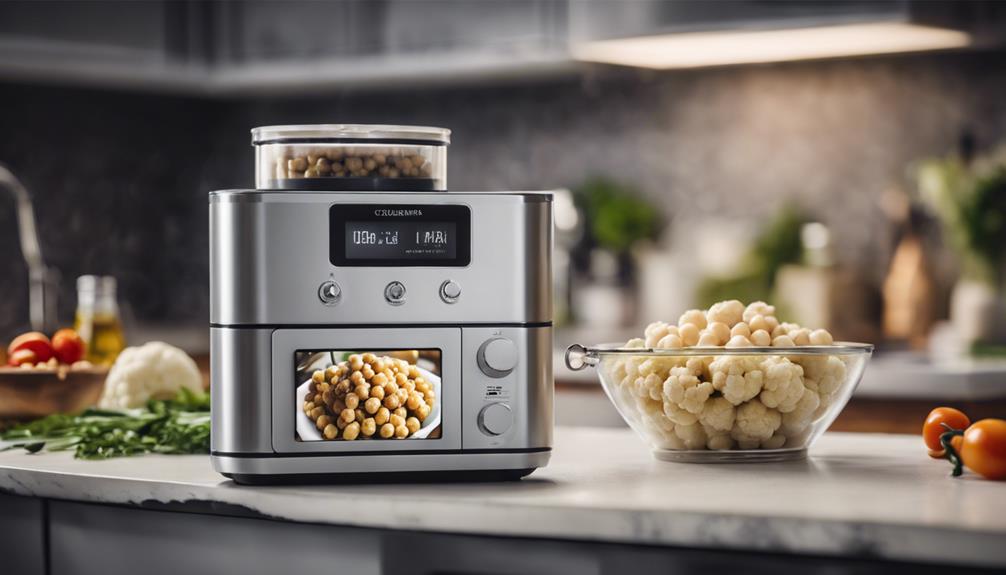
Sous Vide technology, originating in the 1960s, revolutionized culinary practices by introducing precise temperature control.
This innovative cooking method involves vacuum-sealing food in bags and immersing it in a water bath at a consistent temperature.
Sous Vide has gained popularity for its ability to cook ingredients to perfection, enhancing flavors and textures in dishes.
Sous Vide History
The origins of sous vide technology date back to the late 18th century when the concept of cooking food in a vacuum-sealed environment was first explored. This innovative cooking method has its roots in French cuisine, where chefs initially experimented with vacuum sealing ingredients to preserve flavors and enhance textures.
Over time, sous vide has evolved from a preservation technique to a modern culinary practice that's widely used in professional kitchens and home cooking.
In recent years, sous vide has gained popularity for its precise temperature control and ability to cook food evenly, resulting in dishes that are consistently delicious. The technique involves placing ingredients in a vacuum-sealed bag and cooking them in a water bath at a controlled temperature for an extended period. This gentle cooking process helps retain the natural flavors and nutrients of the food while ensuring a perfect doneness level.
With its versatility and consistent results, sous vide has become a staple in modern culinary applications, offering chefs and home cooks a new way to explore flavors and textures in their dishes.
Culinary Innovation
The culinary innovation of sous vide technology can be traced back to the late 18th century. Initially developed as a method to preserve food, sous vide has evolved into a popular cooking technique known for its precision and consistent results.
Over time, chefs have embraced sous vide for its ability to enhance flavor experimentation and keep up with culinary trends.
One key aspect of sous vide innovation lies in ingredient sourcing. Chefs can now source high-quality ingredients globally, ensuring the best flavors in their sous vide dishes.
Additionally, presentation techniques have been revolutionized by sous vide cooking. The precise control over cooking temperatures allows for beautifully plated dishes that aren't only delicious but also visually appealing.
As sous vide technology continues to advance, chefs are pushing the boundaries of culinary creativity. From perfecting traditional recipes to inventing new flavor combinations, sous vide has become a staple in modern kitchens for those looking to elevate their cooking skills.
Precision Cooking Technology
Originating in the late 18th century, sous vide technology revolutionized precision cooking methods by introducing a controlled temperature environment for culinary experimentation. This technology offers significant equipment benefits, allowing for precise temperature control throughout the cooking process.
By vacuum-sealing ingredients in airtight bags and cooking them in a water bath at a consistent temperature, sous vide guarantees even heat distribution and ideal flavor infusion.
Sous vide cooking techniques involve sealing food in a bag and immersing it in a water bath maintained at a specific temperature for an extended period. This method allows flavors to intensify and textures to develop without the risk of overcooking.
The controlled environment preserves the natural juices and nutrients of the ingredients, resulting in tender and flavorful dishes.
The precise temperature control of sous vide technology not only enhances the cooking process but also provides a platform for creative experimentation with flavors and textures. Whether you're infusing herbs, marinades, or spices into your dish, sous vide technology offers a reliable way to achieve consistent and delicious results.
Key Salad Components
Consider incorporating various textures and flavors to enhance the overall appeal of your Sous Vide Cauliflower and Chickpea Salad. To create a balanced and flavorful dish, focus on key components and explore salad variations to suit your taste preferences.
Here are some essential elements to include in your salad:
- Crunchy Chickpeas: Roasted chickpeas add a satisfying crunch to your salad and are packed with protein.
- Tender Cauliflower: Sous vide cauliflower offers a tender texture and locks in its natural flavors.
- Fresh Herbs: Adding herbs like parsley or cilantro can bring a burst of freshness to your salad.
- Creamy Dressing: A creamy tahini or yogurt-based dressing can tie all the ingredients together while adding a velvety texture.
- Citrus Zest: Sprinkling citrus zest over your salad can provide a zingy and aromatic touch, elevating the overall flavor profile.
Top-Rated Salad Recipes
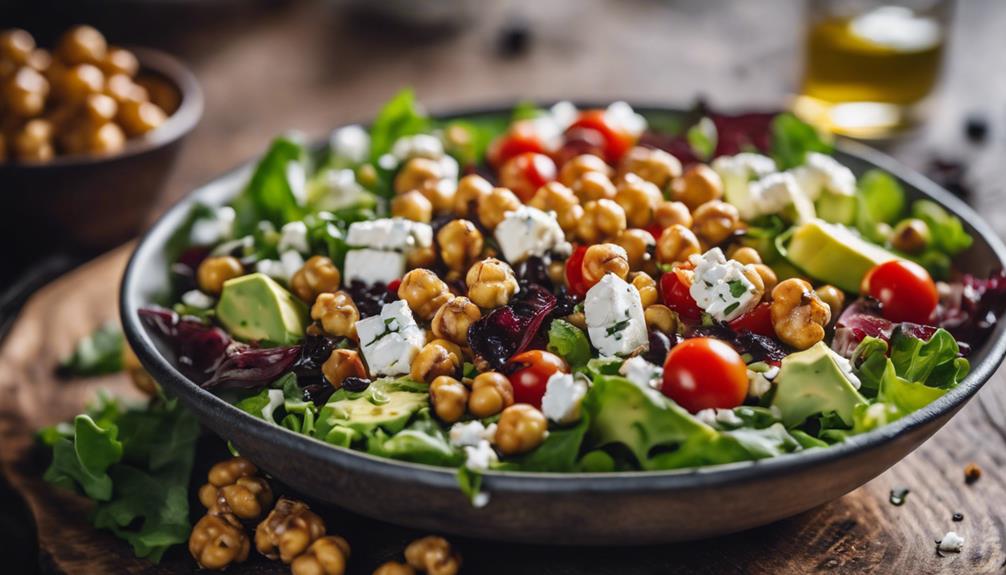
Looking for some top-rated salad recipes to add to your repertoire? Check out these popular choices:
- The Cauliflower Chickpea Salad Recipe, perfect for a light and flavorful meal.
- The crispy Cauliflower Fritters Recipe for a delightful snack.
- The wholesome Cauliflower Rice Bowl Recipe that's both nutritious and satisfying.
These recipes offer a variety of ways to enjoy cauliflower in delicious and creative ways, making them a hit for any occasion!
Cauliflower Chickpea Salad Recipe
For a delightful and nutritious meal, try making this top-rated Cauliflower Chickpea Salad Recipe. This dish combines the nutty flavors of roasted cauliflower with the protein-packed goodness of chickpeas, creating a satisfying and healthy option for lunch or dinner.
- Ingredients:
- 1 head of cauliflower
- 1 can of chickpeas
- Olive oil
- Lemon juice
- Fresh herbs (such as parsley or cilantro)
- Instructions:
- Preheat the oven and roast the cauliflower until golden brown.
- Drain and rinse the chickpeas before roasting them with the cauliflower.
- Toss the roasted vegetables with olive oil, lemon juice, and herbs.
- Season with salt and pepper to taste.
- Serve the salad warm or at room temperature.
This Cauliflower Chickpea Salad Recipe isn't only simple to make but also packed with flavors and nutrients. Enjoy the combination of textures and tastes in this easy-to-follow recipe!
Cauliflower Fritters Recipe
Discover a delicious twist on traditional salad recipes with this top-rated Cauliflower Fritters Recipe. These crispy fritters are a perfect way to enjoy cauliflower in a new and exciting form while providing healthy snack ideas.
Here are some key points to keep in mind when making cauliflower fritters:
- Ingredients: Gather cauliflower, eggs, breadcrumbs, grated cheese, and seasonings like salt and pepper.
- Preparation: Start by steaming or boiling the cauliflower until tender, then mash it and mix with the other ingredients to form a batter.
- Cooking Method: Heat oil in a pan and spoon the batter into fritters, flattening them slightly. Cook until golden brown on both sides.
- Serving Suggestions: Enjoy the cauliflower fritters hot as a snack or side dish, paired with a dipping sauce like tzatziki or marinara.
- Storage Tips: Store any leftover fritters in an airtight container in the fridge for a quick grab-and-go snack option.
These cauliflower fritters offer a flavorful and satisfying way to incorporate more veggies into your diet while exploring new flavors.
Cauliflower Rice Bowl Recipe
To continue exploring innovative ways to enjoy cauliflower in salads, consider trying out a flavorful Cauliflower Rice Bowl Recipe. This recipe offers a delightful twist on traditional rice bowls, incorporating cauliflower rice alternatives that are both nutritious and delicious.
Here are some tips to elevate your cauliflower rice bowl experience:
- Roasted Chickpeas: Add a crunchy texture and protein boost by topping your bowl with crispy roasted chickpeas.
- Avocado Slices: Creamy avocado slices bring a rich and creamy element to your cauliflower rice bowl.
- Pickled Red Onions: Tangy pickled red onions add a burst of flavor that complements the earthy cauliflower rice.
- Fresh Herbs: Sprinkle chopped fresh herbs like cilantro or parsley over your bowl for a pop of freshness.
- Lemon Tahini Dressing: Drizzle your cauliflower rice bowl with a zesty lemon tahini dressing for a tangy finish that ties all the flavors together.
Experiment with these chickpea salad variations to create a customized cauliflower rice bowl that suits your taste preferences.
Salad Dressing Secrets
When it comes to salad dressings, think about the exciting flavor combinations you can create.
Consider the differences between homemade and store-bought dressings regarding taste and freshness.
Lastly, make sure to store your dressings properly to maintain their quality and flavor.
Dressing Flavor Combinations
Enhance your salad experience by exploring creative dressing flavor combinations that elevate the flavors of your dish. When it comes to flavor pairings, the possibilities are endless. Consider experimenting with dressing variations like a tangy balsamic vinaigrette, creamy avocado-lime dressing, or a zesty lemon tahini blend. These dressing variations can transform your salad from ordinary to extraordinary.
For those looking to shake things up, ingredient substitutions offer a fresh take on classic dressings. Try swapping traditional olive oil for toasted sesame oil or substituting honey with maple syrup for a unique twist. These unique combinations can add depth and complexity to your salad, surprising your taste buds with every bite.
Whether you prefer sweet, savory, or a combination of both, finding the perfect dressing flavor combination is key to a delicious salad. Don't be afraid to mix and match different ingredients to discover your own signature dressing that takes your salad to the next level.
Homemade Vs Store-Bought
Consider the advantages and drawbacks of homemade versus store-bought salad dressings to uncover the secrets behind perfecting your salad flavors.
When it comes to homemade freshness versus store-bought convenience, homemade dressings often stand out for their use of fresh ingredients and customizable flavors. Making your own dressing allows you to control the quality of the ingredients, tailoring the taste to your preference.
However, store-bought dressings offer quick solutions for busy days, saving time and effort in the kitchen.
In terms of cost comparison, homemade dressings tend to be more economical in the long run as you can buy ingredients in bulk and avoid the markup of pre-packaged options. A taste test between homemade and store-bought dressings can reveal distinct flavor profiles, with homemade versions often tasting fresher and more vibrant.
Experimenting with different recipes can help you find the perfect balance of flavors that elevate your salads to the next level.
Dressing Storage Tips
To guarantee your homemade or store-bought salad dressings maintain their freshness and flavor, proper dressing storage is crucial. Dressing longevity and flavor preservation can be secured by following some simple yet effective tips.
Initially, store your salad dressings in airtight containers to prevent exposure to air, which can cause oxidation and lead to flavor deterioration. Additionally, keeping dressings refrigerated at all times, even if they're vinegar-based, helps maintain their taste and quality for a longer period. Proper storage techniques also include shaking or stirring the dressing before each use to ensure the ingredients are well mixed and distributed evenly.
When storing homemade dressings, be mindful of the ingredients' shelf life and expiration dates. It's vital to label the container with the preparation date to track freshness accurately. If you notice any changes in color, consistency, or smell, it's best to discard the dressing to avoid any risk of consuming spoiled ingredients. By following these storage tips, you can enjoy flavorful and delicious salads every time.
Final Thoughts
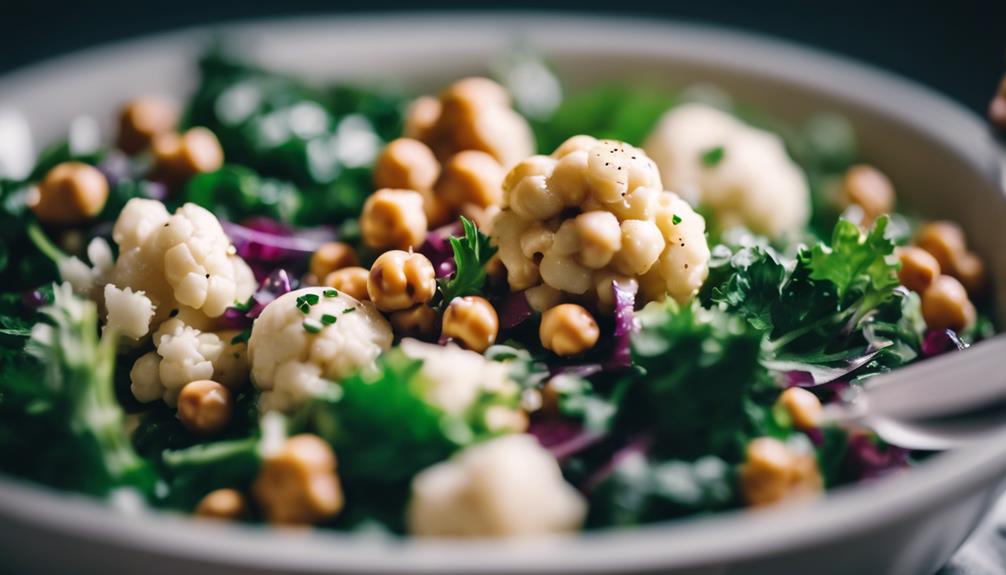
If you're looking for a flavorful and nutritious salad to add to your repertoire, this Sous Vide Cauliflower and Chickpea Salad is a must-try.
The benefits of using sous vide for the cauliflower in this salad are evident in the perfectly cooked, tender texture it provides. The taste comparison between traditionally cooked cauliflower and sous vide cauliflower is remarkable, with sous vide retaining more flavor and nutrients.
When presenting this salad, consider arranging the chickpeas, cauliflower, and any additional toppings in an aesthetically pleasing manner to enhance the overall visual appeal.
Serving suggestions include adding a drizzle of lemon vinaigrette or a sprinkle of fresh herbs to elevate the flavors further.
Frequently Asked Questions
Can I Use Frozen Cauliflower for This Salad Recipe?
You can use frozen cauliflower, but fresh is better for texture. Fresh cauliflower holds up well in sous vide, retaining its firmness and flavor. The benefits of sous vide include even cooking and enhanced taste.
Is It Necessary to Soak Chickpeas Before Cooking Them Sous Vide?
You don't have to soak chickpeas before sous vide cooking. Chickpea texture might vary, but they can cook well without soaking. Adjust cooking time as needed for desired softness. Enjoy experimenting with chickpeas in your recipes!
How Can I Add a Smoky Flavor to the Cauliflower in This Salad?
To add a smoky flavor to your cauliflower, try grilling techniques with wood chips or using liquid smoke and smoked paprika. These options will infuse your dish with a delicious smokiness that complements the flavors.
Can I Substitute Chickpeas With a Different Type of Legume?
If you want to change chickpeas, lentils make a great substitution. Lentils offer various flavor profiles and can be prepared in numerous ways. They also provide high nutritional value, offering a protein-rich and fiber-packed alternative.
What Other Vegetables Can Be Cooked Sous Vide for Salads?
For your salads, you can sous vide carrots and potatoes. Sous vide retains nutrients and flavors in vegetables, but it takes longer than traditional cooking methods. Experiment with different textures and tastes to find your favorite combination.
Conclusion
To sum up, salad sous vide cauliflower and chickpea salad offers a unique twist on a classic dish, highlighting the versatility of sous vide technology.
By combining key components like roasted cauliflower, crispy chickpeas, and a flavorful dressing, this recipe creates a delicious and nutritious meal that's sure to impress.
Experiment with different ingredients and flavors to customize your salad to your liking, and enjoy the benefits of this innovative cooking method in your own kitchen.
